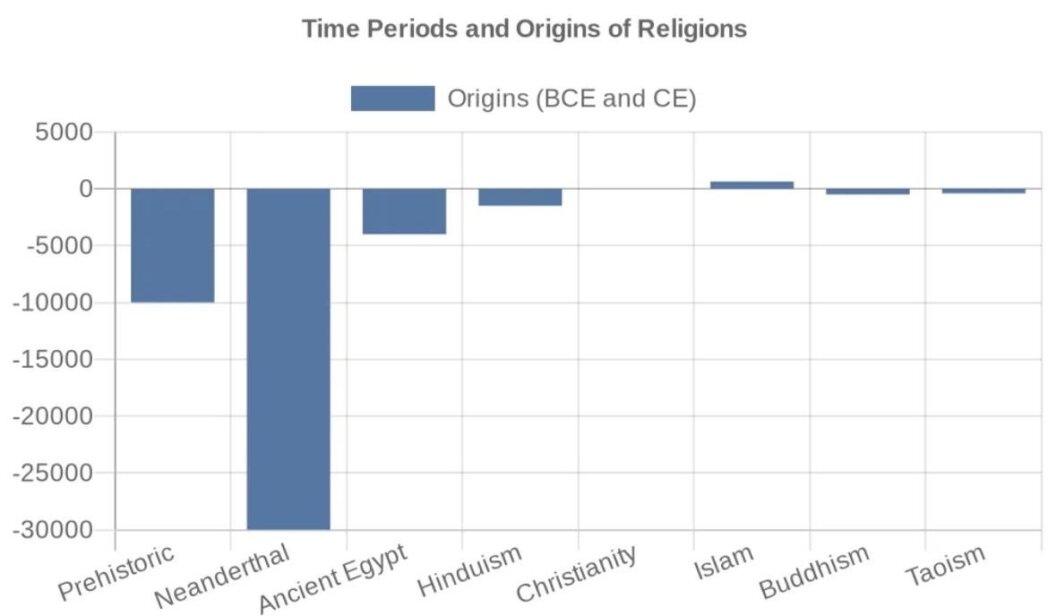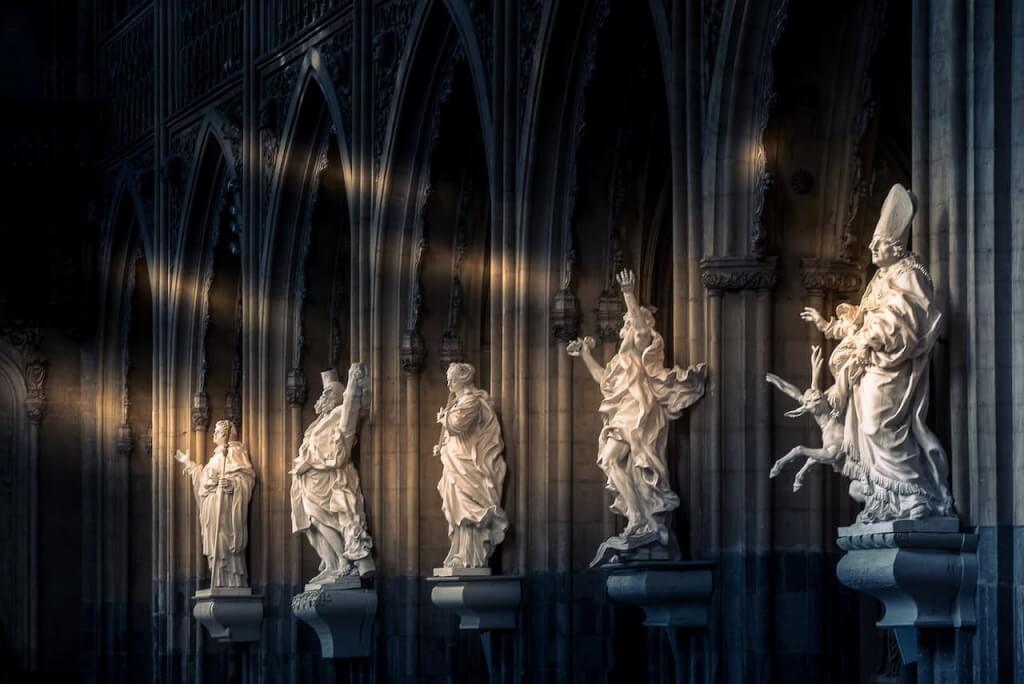The roots of religious beliefs and their emergence remain a topic of intense discussion among scholars. Though pinpointing the exact inception of religion remains elusive, consensus suggests that early humans sought religious beliefs to comprehend and navigate their surroundings.

This piece dives into the journey of religion’s growth and transformation throughout history.

Religion’s Dawn in Prehistoric Times
During prehistoric times, as human societies burgeoned in complexity, signs of early religious beliefs surfaced. Neanderthal artifacts hint at burial customs and the use of symbolic items, like beads and shells. As societies grew intricate, religion cemented its position, intertwining with everyday life. In numerous ancient civilizations, religion demystified nature’s wonders and was a conduit to divine advice and safety.
From the Sands of Egypt to the Valleys of India
The annals of history have tales of ancient Egyptian spirituality dating back to the fourth millennium BCE. This belief system was enmeshed with the Nile’s landscape, boasting an intricate web of deities. Noteworthy are the Egyptians’ grandiose burial traditions and faith in life beyond death.
Contrastingly, around 1500 BCE in the Indian subcontinent, Hinduism emerged. This multifaceted faith system showcases an array of deities and spiritual philosophies. It champions spiritual practices like meditation and yoga. Christianity, birthed in the Middle East around the first century CE, revolves around Jesus Christ’s teachings. This faith, underlining love, faith, and absolution, has indelibly shaped Western civilization and amasses followers globally.
Parallelly, Islam, emanating in the Middle East during the seventh century CE, is anchored in Prophet Muhammad’s teachings. It accentuates submission to Allah’s decree and has dramatically molded Middle Eastern and North African cultures. Religions like Buddhism from ancient India emphasize introspection and awareness. Meanwhile, Taoism, originating from China, highlights the essence of harmonious existence with nature.
Life and Religion Among Early Communities
In society’s infancy, religion was its heartbeat. It unraveled nature’s intricacies and was a solace during tribulations. Primitive communities, comprising extended families or tribes, harmonized their existence with nature’s ebb and flow. Their spirituality was steeped in animism, seeing every natural entity as sacred. Through rituals, chants, and symbols, these early communities believed they could beseech nature’s spirits for blessings or protection. The Native American faith epitomizes this belief system, advocating nature’s sanctity and harmony.
In these early societies, religious and political hierarchies often merged. Religious figureheads not only led spiritual ceremonies but also held sway in communal decisions. Beyond the community, individuals drew personal comfort and assurance from these spiritual beliefs, especially in an unpredictable world. Today, echoes of these primitive spiritual practices reverberate in contemporary religious ceremonies, underscoring religion’s timeless influence on human society.
Reflecting on Religion’s Legacy
Tracing religion’s genesis remains intricate, but its profound impact on human evolution is irrefutable. From archaic to modern societies, religious beliefs have been humanity’s compass, illuminating their world and offering solace in tumultuous times. As seen from ancient Egyptian rites to modern Christian and Islamic practices, faith remains a cornerstone for countless global denizens.
The Enduring Quest for Spiritual Understanding
Religion, in its many forms, serves as a testament to humanity’s eternal quest for understanding and a deeper connection to the universe. The multifaceted nature of religious beliefs showcases the human spirit’s adaptability and our relentless search for meaning in the face of life’s uncertainties.
The Ritualistic Foundations of Religion
At the heart of many religions are rituals, which serve as symbolic acts meant to connect humans to a higher power or to the mysteries of existence. Rituals, in their varied forms, are a universal feature of human societies. From the Aboriginal Dreamtime ceremonies in Australia that trace back tens of thousands of years, to the Zen Buddhist tea ceremonies in Japan, rituals bridge the gap between the spiritual realm and our everyday lives. They also help foster a sense of community, belonging, and continuity.
The Mayans, for instance, had an elaborate calendar system intertwined with their religious rituals. Their ceremonies, dedicated to their gods, played a pivotal role in their societal structure, marking important agricultural cycles and celestial events. Such rituals ensured the society’s harmony with nature and the cosmos.
The Philosophical Underpinnings of Faith
While rituals offer a tangible connection to the divine, the philosophy behind each religion offers a more abstract and intellectual pathway. In ancient Greece, for example, the birthplace of Western philosophy, thinkers like Socrates, Plato, and Aristotle often grappled with questions about divinity, morality, and the purpose of life. Though not religious in a traditional sense, their philosophical inquiries laid the groundwork for many religious and spiritual ideologies that followed in the Western world. In the East, Confucianism, founded by Confucius in China around 500 BCE, was not just a religion but a comprehensive worldview and moral code. While it incorporated rituals, it was the philosophy of right behavior and societal harmony that became its enduring legacy.
Religion’s Impact on Art and Culture
Religious beliefs have also been a rich source of inspiration for art and culture. Gothic cathedrals of Europe with their towering spires, intricate stained glass, and awe-inspiring frescoes were not just places of worship but also masterpieces of architecture and art. They encapsulated Christian ideologies and showcased the epoch’s artistic brilliance.
Similarly, in the Mughal Empire in India, the fusion of indigenous Hindu art with Persian influences, under the aegis of Islam, led to the creation of architectural wonders like the Taj Mahal. Such edifices are not just religious monuments but are also a testament to the cultural amalgamation and artistic renaissance spurred by religious influences.
Challenges and Evolution
While religion has often been a source of solace and community, it has not been without challenges. Over centuries, debates, schisms, and even wars have arisen due to differing religious ideologies. The Protestant Reformation in 16th century Europe, spearheaded by Martin Luther, is a prime example. It not only led to the division of the Christian church but also redefined the political landscape of Europe.
However, such challenges have also led to introspection and evolution within religious practices. The rise of the Sufi movement in Islam, emphasizing a personal connection with the divine through poetry and music, or the Bhakti movement in India, focusing on personal devotion over ritualistic practices, showcase the fluid nature of religious beliefs.
Conclusion
From its nascent stages in prehistoric times to its current multifarious forms, religion has remained an intrinsic part of human history. It has provided solace during times of crisis, fostered community bonds, and inspired artistic and philosophical masterpieces. Its ever-evolving nature reflects humanity’s unending journey towards understanding our place in the cosmos. While the origin of religion might remain shrouded in mystery, its enduring legacy and impact on human civilization are undeniable. Whether through rituals, philosophy, or artistic expressions, religion continues to shape our worldview and guide our steps in an ever-changing world.


No Responses